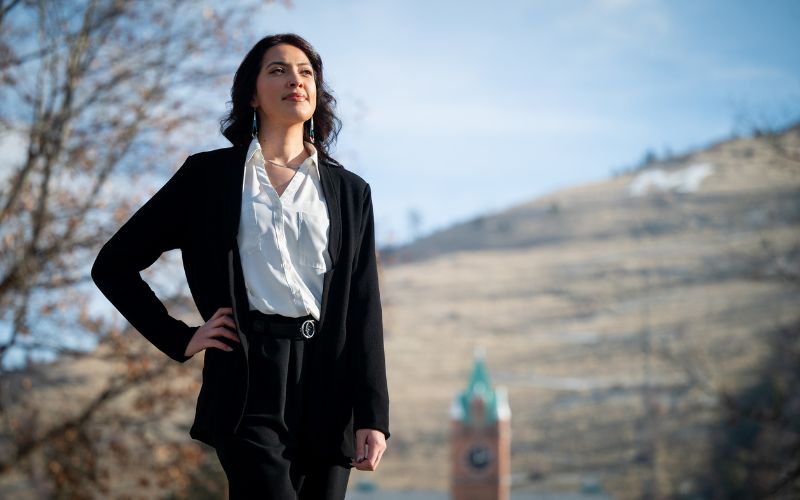
- Details
- By Elyse Wild
Haley Omeasoo, the founder and executive director of Ohkomi Forensics, was 20 years old when she saw a missing persons flier for her former high school classmate, Ashley Loring Heavyrunner.
Seeing the face of someone she knew on a missing persons flier wasn’t a new experience for Omeasoo, a citizen of the Hopi Tribe and a Blackfeet descendant.
“It's kind of a normal thing, you see a post on Facebook about so and so being missing or an attempt to locate, and a lot of the time, they do end up showing up,” Omeasoo told Native News Online.
But Heavyrunner didn’t show up. Omeasoo, who was studying for her bachelor’s degree in pre-med at the University of Montana, watched from a distance as Heavyrunner’s case took on the hallmarks of the Missing and Murdered Indigenous Peoples (MMIP) crisis: limited and apathetic law enforcement efforts, and a family begging for answers while leading their own investigation. Authorities waited two months to launch an official investigation into HeavyRunner’s disappearance, and a key piece of evidence was misplaced before it was tested for DNA.
“Ashley was over the age of 18, and I feel like her case wasn't taken very seriously because she was an adult,” Omeasoo said. “They look at her case and think, ‘She’s probably out doing whatever, she’ll come home.’ And it’s been more than six years now.”
Heavyrunner’s case galvanized Omeasoo in a way nothing had before.
“It’s why I decided to go into forensics,” she said.
Omeasoo, a doctoral student in the Forensic and Molecular Anthropology Program at the University of Montana, founded Ohkomi Forensics earlier this year. The Missoula, Mont.-based nonprofit brings to MMIP cases what is often lacking: field and excavation work, forensics anthropology and DNA testing.
The MMIP crisis is prevalent across the country, with Indigenous peoples being murdered at a rate ten times the national average. Homicide is one of the leading causes of death for Native women. While the Bureau of Indian Affairs estimates there are 4,200 unsolved MMIP cases, the actual number is likely higher, Native advocates say. According to the Urban Indian Health Institute, Montana ranks among the top states for the highest number of MMIP cases per capita.
Omeasoo, who grew up on the 1.5 million-acre Blackfeet Reservation on the eastern border of Glacier National Park, says it wasn’t until she moved to Missoula for college that she realized the gravity of the crisis.
"Growing up on the reservation, issues like this kind of seem normal. When I moved off of the reservation, I realized it is not normal,” Omeassoo said.
Advocates and lawmakers have identified multiple drivers of the MMIP crisis: egregiously underfunded tribal law enforcement; jurisdictional confusion between tribal, local, state police and the BIA; exclusion of Indigenous people in data; and underwhelming media coverage.
With Ohkomi Forensics, Omeasoo has become part of the legion of Native people erecting their own resources to fill these yawning gaps that leave many cases unsolved. MMIP groups span Indian Country, leading searches, posting information on missing people on social media platforms, acting as intermediaries between families and law enforcement, and raising awareness.
Nonprofits, such as the Sovereign Bodies Institute, gather data on MMIP where there is none to paint a clearer picture of the crisis. Some, like Lissa Yellow Bird Chase of Sahnish Scouts, Bernadine Beyale of Four Corners K-9 Search and Rescue, and now Omeasoo, use their distinct skills to aid in the recovery of missing or murdered people and the gathering of evidence.
Forensic anthropology, Omeasoo’s area of expertise, involves the identification of deceased individuals whose remains are decomposed, burned, mutilated or unrecognizable. Forensic anthropology has proven to be key in solving cold cases, some more than a century old. Along with identifying remains, forensic anthropologists can identify how and when an individual died.
With tribal law enforcement agencies being chronically underfunded, services like Ohkomi could prove essential in recovering MMIP and advancing justice.
Charlene Sleeper (Cheyenne & Arapahoe, Chippewa-Cree), who runs a Billings, Mont. based MMIP group, says she was thrilled when Omeasoo started Ohkomi. She points out that forensics are not only key in identifying remains and determining what happened, but in bringing justice that is not often seen in Indian Country.
"Forensics are key to gathering reliable evidence to support prosecution in these cases," Sleeper said. “I celebrate that she is doing this, that her organization exists.”
Ohkomi Forensics is the nation’s only forensics lab dedicated to MMIP. It currently utilizes lab facilities at the University of Montana, where Omeasoo assembles a team of volunteers with various areas of expertise — dental forensics, medical examination, digital forensics — to assist in field searches and casework.
While Omeasoo is focusing her efforts on MMIP cases on the Blackfeet Reservation — such as one involving Arden Pepion, a 3-year-old who went missing in 2021 — she hopes to forge agreements with other Montana tribes to utilize her services.
“The dream is to get my own lab built that would be specifically for MMIP cases in Montana and surrounding states, and possibly into Canada,” she said.
During her nine years in the field, Omeasoo has worked with the remains of individuals she doesn’t know. Working on the reservation — her home — is different.
“It's harder to go back on the reservation, even if I don't know the family,” she said. “But that's what we say in my culture, we are all relatives, we are all related and connected somehow."
In the Blackfeet language, Ohkomi means “to use one's voice.”
“The idea of what we do is to restore the voice of those that can no longer speak for themselves,” Omeasoo said. “And so that's kind of what I hope my company will do is to kind of tell their story, you know, and use our voices for them.”
More Stories Like This
Johns Hopkins Collecting Tribal Success Stories from $1.5B Opioid SettlementArizona MMIP Task Force Holds Listening Session for Survivors and Families
‘A good stew is a story’ Blackfeet buffalo rancher shares Three Sisters Buffalo Stew recipe
National Indian Health Board Urges Congress to Extend Enhanced Premium Tax Credits
$1.25 Million Grant Gives Hope to Tolowa Dee-ni' Nation Amid Housing Crisis


